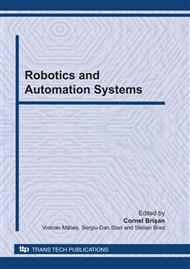[1]
Pat Langley, John E. Laird, Seth Rogers, Cognitive architectures - Research issues and challenges, Cognitive Systems Research 10, 141-160, (2009).
DOI: 10.1016/j.cogsys.2006.07.004
Google Scholar
[2]
Fakhreddine Karray, Milad Alemzadeh, Jamil Abou Saleh, Mo Nours Arab, Human-Computer Interaction: Overview on State of the Art, International journal on smart sensing and intelligent systems, vol. 1, no. 1, (2008).
DOI: 10.21307/ijssis-2017-283
Google Scholar
[3]
Andreas Nüchter, Joachim Hertzberg, Towards semantic maps for mobile robots, Robotics and Autonomous Systems 56, 915-926, (2008).
DOI: 10.1016/j.robot.2008.08.001
Google Scholar
[4]
Yingxu Wang, Vincent Chiew, On the cognitive process of human problem solving, Cognitive systems research 11, 81-92, (2010).
DOI: 10.1016/j.cogsys.2008.08.003
Google Scholar
[5]
Matthew M. Botvinick, Yael Niv, Andrew C. Barto, Hierarchically organized behavior and its neural foundations: A reinforcement learning perspective, Cognition 113, 262-280, (2009).
DOI: 10.1016/j.cognition.2008.08.011
Google Scholar
[6]
Robert P. Marinier III, John E. Laird, Richard L. Lewis, A computational unification of cognitive behavior and emotion, Cognitive Systems Research 10, 48-69, (2009).
DOI: 10.1016/j.cogsys.2008.03.004
Google Scholar
[7]
Pat Langley, Cognitive Architectures and General Intelligent Systems, Computational Learning Laboratory, Center for the Study of Language and Information, Stanford University, (2006).
Google Scholar
[8]
Sophie Forster, Nillie Lavie, Harnessing the wandering mind: The role of perceptual load, Cognition 111, 345-355, (2009).
DOI: 10.1016/j.cognition.2009.02.006
Google Scholar
[9]
Ron Sun, Theoretical Status of computational cognitive modeling, Cognitive Systems Research 10, 124-140, (2009).
DOI: 10.1016/j.cogsys.2008.07.002
Google Scholar
[10]
Wolfram Erlhagen, Estela Bicho, The dynamic neural field approach to cognitive robotics, Journal of Neural Engineering 3, R36-R54, (2006).
DOI: 10.1088/1741-2560/3/3/r02
Google Scholar
[11]
Jen-Tzung Chien, Chuang-Hua Chueh, Joint acoustic modelling for speech recognition, Speech Communication 52, 223-235, (2010).
DOI: 10.1016/j.specom.2009.10.003
Google Scholar
[12]
Tom Froese, Tom Ziemke, Enactive artificial intelligence: Investigating the systemic organization of life and mind, Artificial Intelligence 141, 466-500, (2009).
DOI: 10.1016/j.artint.2008.12.001
Google Scholar
[13]
Frank vand der Velde, Marc de Kamps, Learning of control in a neural architecture of grounded language processing, Cognitive systems research 11, 93-107, (2010).
DOI: 10.1016/j.cogsys.2008.08.007
Google Scholar
[14]
Wei-Lin Wu, Ru-Zhan Lu, Jian-Yong Duan, Hui Liu, Feng Gao, Yu-Quan Chen, Spoken language understanding using weakly supervised learning, Computer Speech and Language 24, 358-382, (2010).
DOI: 10.1016/j.csl.2009.05.002
Google Scholar
[15]
Michael Felsberg, Johan Wiklund, Gosta Granlund, Exploratory learning structures in artificial cognitive systems, Image Vision and Computing 27, 1671-1687, (2009).
DOI: 10.1016/j.imavis.2009.02.012
Google Scholar
[16]
Meinou H. de Vries, Padraic Monaghan, Stefan Knecht , Pienie Zwitserlood, Syntactic structure and artificial grammar learning: The learnability of embedded hierarchical structures, Cognition 107, 763-774, (2008).
DOI: 10.1016/j.cognition.2007.09.002
Google Scholar
[17]
Alexandra Kirsch, Robot learning language - Integrating programming and learning for cognitive systems, Robotics and Autonomous Systems 57, 943-§954, (2009).
DOI: 10.1016/j.robot.2009.05.001
Google Scholar
[18]
Qi Zhang, A computational account of dreaming: Learning and memory consolidation, Cognitive Systems Research 10, 91-101, (2009).
DOI: 10.1016/j.cogsys.2008.06.002
Google Scholar


